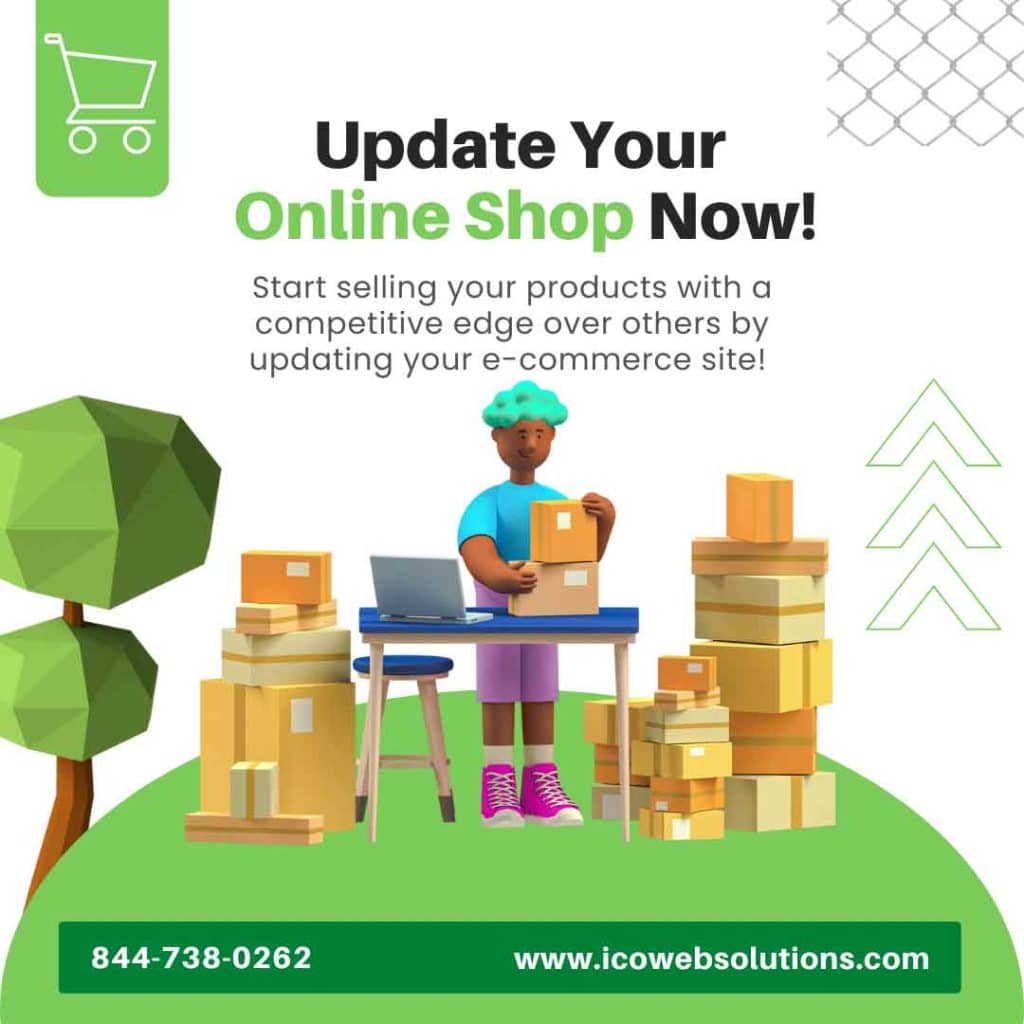5 eCommerce Website Updates You Need to Make Right Away

So, users or customers can be expected to continue browsing and shopping online to explore and shop for new products, and brands.
For this reason, it is of underlying importance to keep your eCommerce website up to date to provide a seamless experience for customers.
More than that, with so many novel advancements in the digital sphere today, you need to understand, discover and fill gaps in your site immediately to keep users engaged and involved.
Technology is constantly evolving, so there will always be something extra to do to stay ahead of the game. For all that, here are the most significant five updates you need to make today with regard to urgency. Ensure you do not put off these updates to maximize your benefits for 2022-23.
1. Optimize Your Website with Keywords
Search engine optimization (SEO) is not a buzzword, in fact, it’s real; very real! Moreover, it’s not a new concept in the digital marketing world, but if you have yet to start building a robust strategy for your site’s SEO, now is the time to do so. Having your site come up in the top SERPs can bring many customers to your store–online and offline.
Identify relevant keywords to optimize your eCommerce site efficiently. This means you must include branded and non-branded keywords.
With voice search gaining a lot of popularity, the inclusion of long tail keywords become more important than ever. The long tail keywords that you include should be researched by thinking of them as full sentences or questions that someone may ask in real face-to-face conversations.
Here are some extra tips that can help you in your keyword research:
-
Study your competitors
Besides looking at your ranking position, you should also analyze your competitor’s performance. Top ranking in the SERP translates to conversion, so it’s imperative for you to study and improve your optimization efforts.
-
Find a good balance between competition and keyword search volume
Apparently, all the business owners want to target keywords with high volume. But you also need to take the competition into the account. If most of your competitors are already targeting the same keywords, it will be more challenging to rank high for them.
-
Ensure your keywords match your users’ search objective
The search intent of a user can be navigational, informational, or transactional. So, you have to analyze and use the correct keywords on the basis of your users’ search goals.
-
Determine the right pages to add specific keywords to your eCommerce site
The next big thing after choosing the keywords is their placement in the most relevant pages and sections. Do not haphazardly place the keywords on any page, identify the correct page/post/section for a specific keyword matching the overall content on that page.
Undoubtedly, keywords are just a part of eCommerce SEO, but they definitely make a huge difference. So, along with optimizing your product listings and descriptions with targeted keywords, you also need to create high-quality and unique content that offers useful information to users.
2. Use Up To Date Security and Payment Systems
Of course, you need to go over and above to secure your eCommerce site and watch over possible cyberattacks. It is essential in 2022 as the number of online shoppers has increased and while doing so entering sensitive payment info can easily go into the wrong hands.
Violation of Ecommerce data can come in many forms—hijacked information, assuming passwords, phishing, malware viruses, etc. No matter what, you must have appropriate security measures against any of these to stay away from costly consequences.
Cyberattacks cost businesses many hundred thousand dollars. Apart from this, they can also cost your name as users may lose trust and confidence in your brand.
To protect the security of your eCommerce website, here are some important steps you should consider:
- Use TLS/SSL encryption over the HTTP protocol for the whole website.
- Do not save customers’ debit/credit card data or other sensitive payment information.
- Set password requirements to assist clients to protect themselves.
- Work with security plug-ins, if suitable.
- Regularly back up your site data to keep the information safe.
- Keep an eye on on-site security at all times.
3. Enhance UX Gaps and Concerns
Now that users are more taken up with the online sphere, they have also become more analytical of the websites they visit. If they do not find the shopping experience smooth and seamless, there is a high probability they may leave without buying anything.
Considering this, you should plan a survey to discover user experience (UX) gaps and problems on your eCommerce site and tune them up accordingly. Prior to conducting tests, take a look at your site’s Google Analytics to find out where your site’s performing failing.
By taking these steps, you can find out which parts of a shopper’s session most users drop off and work on improving these areas.
To help you in your survey and analysis, here are some key points to check in your UX:
- Control your page load time and keep it at or below two seconds.
- Ensure your site is responsive and mobile-friendly.
- Product search should be easy and optimized.
- Make certain that the product’s description is accurate, and clear, with high-quality images.
- Provide clear and direct navigation.
- Shape up the checkout section.
4. Measure Your Results with Analytics
Measuring and tracking results with analytics is very essential in this day and age. When it comes to an e-commerce site’s performance tracking each step of a customer journey is crucial to influencing conversions and delivering a good user experience.
With e-commerce analytics, you can get important and helpful information about your shoppers’ behavior and actions and find room for enhancing your digital marketing plans.
You can start by setting up Google Analytics for your eCommerce website. It is completely free to use and allows you to track and measure key performance indicators (KPIs) to help you learn about your site’s visitors in a better way.
By gaining insights from Google Analytics you can act fast and acknowledge the issues immediately to stop them from getting bigger.
Here are essential metrics that eCommerce websites should track in general:
- Transaction and purchase data
- Customer lifetime assessment
- Organic traffic and site visitors
- Impressions, reach, and engagement
- Conversion ratio
- Onsite activity (views per page, sessions per page)
- Pages most visited by users
- Cart abandonment rate
- Customer retention rate
- Return and refund rate
The above list to track the essential metrics may seem a tad overwhelming. But, monitoring them regularly with the right tools is important for all eCommerce websites.
5. Shift to First-Party and Zero-Party Data
2022 marks a big move in the online space as search engines begin to close down third-party cookies. While the search giant Google has delayed this by a year–to the end of 2023, you should still get ready for the nearing change.
Third-party cookies have been actively involved in building targeted online ad campaigns, so shutting them will have a direct impact on your advertising strategy.
If you have not yet turned in your marketing efforts, you should do this right away to make your mark in your industry.
Undoubtedly, first-party cookies will still be in use, so you can monitor people’s behavior on your eCommerce website.
However, zero-party data is also advancing as an important opportunity in the digital marketing world. It is about getting optional information from users that they willingly share with companies/brands.
Here are some creative ways to collect zero-party data without creating a disturbing experience for users.
-
New User Sign-up
When users register for an account, you can ask them some questions about their interests or pain points, so you can capture their interest by showing initial products they would fancy.
For example, if you specialize in food business, you can ask questions like “What are your favorite cuisine, vegetarian or non-vegetarian, and other similar things?”
-
Interactive Questions
Know your users better by asking them interactive questions while they are browsing to make their shopping experience more useful. For instance, if you run a fashion e-commerce site, you can ask about their style, fashion choices, color preferences, any specific item they are looking for, and others.
The eCommerce site can then provide relevant clothing suggestions for site users to shop.
-
Social Media Engagement
You may not find it significant, but social media engagement tools like IG polls, sliders, and other stickers increase your interaction with your users.
It is simple yet valuable in understanding consumer behavior and preferences in terms of shopping.
-
eCommerce Popups
You can also use conversational popups to collect zero-party data, but it should not be placed such that it disrupts the customer’s experience.
These popups can be about a couple of questions to learn more about the user. And to encourage the users to answer you can incentivize them with something like a discount or free points.
Continue to personalize your marketing efforts with zero-party data. Deliver personalized experiences to keep your site’s users interested and engaged in your products or services.
Moving Forward
As the e-commerce industry becomes more aggressive, so should your digital marketing efforts. Anyone can get lost in the overwhelming technology trends coming out, so start with the most significant things first, listed in this article.
For 2022-23, ensure to implement these five updates mentioned above; to help you draw in more customers, peak online visibility, and boosted competitive edge.
If you are looking for a website designing company in Delhi to design your eCommerce website in India then contact us. Our digital marketing company in India will maximize your results in the most targeted way.





